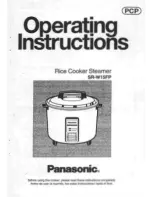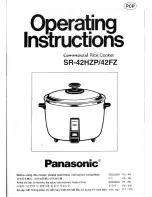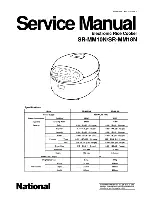
6
ATTENTION: By placing the
marking on this product, we declare, on our own responsibility, compliance to all of
European safety, health and environmental requirements stated in the legislation for this product.
THREE-PHASE ELECTRIC CONNECTION
The cookers that can also be connected to three-phase systems normally are factory built for the single-phase 230V connection
and are supplied with a power cord. Based on the connection system used, install the power cord type indicated in table No.3.
To use the selected connection system change the jumpers on the terminal strip as indicated in the diagram of Fig.23
APPLIANCE MAINTENANCE
ATTENTION: IMPORTANT WARNINGS
For cookers resting on a base
ATTENTION: If the cooker rests on a base, take the measures necessary to prevent the cooker from sliding along the support
base.
For cookers with glass covers
ATTENTION: Before opening the appliance’s glass cover, carefully remove all liquid residues from the top of it.
ATTENTION: Before closing the appliance’s glass cover, make sure that the work surface has cooled.
For cookers with electric ovens
The unit becomes hot during use. Do not touch the heating elements inside the oven.
For cookers with electric ovens
ATTENTION: The accessible parts can become hot during use. Keep children away from the appliance.
For the food warmer compartment (or drop leaf in our case)
ATTENTION: The internal parts of the food warmer can become hot during use.
For glass doors
Do not use abrasive cleaning products or metal spatulas with sharp edges to clean the oven door’s glass since this could
scratch the surface and the glass could break.
Do not use steam cleaners to clean the appliance.
NOTE:
various parts of the cooker heat up reaching temperatures which seem very high but which are actually fully within
safety limits. According to these limits:
1) With the oven on at 200°C for 1 hour, front accessible parts which cannot be grasped, can reach the following temperatures:
-
Control panel: Tmax = Room Tempe60°C
-
Glass of the oven door: Tmax = Room temp60°C
-
Metal part of the oven door: Tmax = Room temp45°C
2) With the oven on at 230°C for 1 hour, the parts which can be grasped, can reach the following temperatures:
-
Plastic knobs: Tmax = Room temp60°C
-
Metal oven door handle: Tmax = Room temp35°C
where the room temperature is the temperature in °C of the place where the appliance is installed.
REPLACING PARTS
Before performing any maintenance operation, disconnect the appliance from the gas supply and electricity network.
To replace parts such as knobs and burners, just remove them from the seats without disassembling any part of the cooker.
To replace parts such as nozzle supports, valves and electric components follow the procedure described in the burner
adjustment paragraph. To replace the valve or the gas thermostat, it is also necessary to disassemble the two rear gas train
brackets, loosening the 4 screws (2 per bracket) that attach it to the rest of the cooker and, unscrew the nuts that attach the
front burner valves to the control support, after removing all the knobs. To replace the gas or electric thermostat, also
disassemble the rear cooker guard, loosening the relative screws, to be able to pull out and reposition the thermostat bulb.
To replace the oven bulb, just unscrew the protection cap that projects out inside the oven.(fig.24)
WARNING: Before replacing the bulb, disconnect the appliance from the electric power supply.
WARNING
: The power cord supplied with the appliance is connected to that appliance with an
X
type connection (in compliance
with standards EN 60335-1, EN 60335-2-6 and subsequent amendments) for which it can be installed without the use of special
tools, with the same type of cord as the one installed.
If the power cord becomes worn or damaged, replace it based on the information reported in table 3 .
WARNING: If the power cord is replaced, the installer shall ensure that the ground cable is longer than the phase
cables and also shall comply with the warnings regarding the electric connection.
Summary of Contents for TS95C61LNE
Page 21: ...21 Fig 1 Fig 2 Fig 3 Fig 4 Fig 5 Fig 6 Fig 7 ...
Page 22: ...22 Fig 9 Fig 10 Fig 11 Fig 12 Fig 13 Fig 14 Fig 15 ...
Page 23: ...23 Fig 16 Fig 17 Fig 18 Fig 19 Fig 20 Fig 21 Fig 22 Fig 23 Fig 24 Fig 25 Fig 26 Fig 27 ...
Page 26: ...26 Fig 57 Fig 58 Fig 59 Fig 60 Fig 61 Fig 62 Fig 63 Fig 64 ...
Page 27: ...27 Fig 65 Fig 66 Fig 67 Fig 68 Fig 69 Fig 70 ...







































